*NURSING > TEST BANK > Lehne PharmACOLOGY Test bank 1 1 1.pdf. ALL CHAPTER QUESTIONS AND ANSWERS. GRADED A+ (All)
Lehne PharmACOLOGY Test bank 1 1 1.pdf. ALL CHAPTER QUESTIONS AND ANSWERS. GRADED A+
Document Content and Description Below
Chapter 1: Orientation to Pharmacology Test Bank MULTIPLE CHOICE 1. The nurse is teaching a patient how a medication works to treat an illness. To do this, the nurse will rely on knowledge of: a... . clinical pharmacology. b. drug efficacy. c. pharmacokinetics. d. pharmacotherapeutics. ANS: D Pharmacotherapeutics is the study of the use of drugs to diagnose, treat, and prevent conditions. Clinical pharmacology is concerned with all aspects of drug–human interactions. Drug efficacy measures the extent to which a given drug causes an intended effect. Pharmacokinetics is the study of the impact of the body on a drug. DIF: Cognitive Level: Comprehension REF: Four Basic Terms TOP: Nursing Process: Implementation MSC: NCLEX Client Needs Category: Physiologic Integrity: Pharmacologic and Parenteral Therapies 2. What does it mean when a drug is described as easy to administer? a. It can be stored indefinitely without need for refrigeration. b. It does not interact significantly with other medications. c. It enhances patient adherence to the drug regimen. d. It is usually relatively inexpensive to produce. ANS: C A major benefit of drugs that are easy to administer is that patients taking them are more likely to comply with the drug regimen. Drugs that are easy to give may have the other attributes listed, but those properties are independent of ease of administration. DIF: Cognitive Level: Comprehension REF: Additional Properties of an Ideal Drug: Ease of Administration TOP: Nursing Process: Assessment MSC: NCLEX Client Needs Category: Physiologic Integrity: Pharmacologic and Parenteral Therapies 3. A patient tells the nurse that he was told by the prescriber that the analgesic he is taking is very effective. Which statement by the patient demonstrates an understanding of the drug’s effectiveness? a. “I don’t have to worry about toxicity, since it takes a large amount of this drug to cause an overdose.” b. “It has no side effects and doesn’t interact with other drugs.” c. “I only have to take it every 12 hours.” d. “It might make me sleepy, and it lessens pain for several hours at a time.” ANS: D A drug is effective if it produces the intended effects, even if it also produces side effects. Because no drug is completely safe, the level of toxicity does not determine effectiveness. All drugs have side effects and many react with other substances; these do not affect the drug’s effectiveness. Ease of administration is independent of a drug’s effectiveness. DIF: Cognitive Level: Comprehension REF: Properties of an Ideal Drug TOP: Nursing Process: Evaluation MSC: NCLEX Client Needs Category: Physiologic Integrity: Pharmacologic and Parenteral Therapies MULTIPLE RESPONSE 1. What are the properties of an ideal drug? (Select all that apply.) a. Irreversible action b. Predictability c. Ease of administration d. Chemical stability e. A simple trade name ANS: B, C, D In addition to predictability, ease of administration, and chemical stability, other properties include a reversible action so that any harm the drug may cause can be undone and a simple generic name, because generic names are usually complex and difficult to remember and pronounce. DIF: Cognitive Level: Comprehension REF: Properties of an Ideal Drug | Additional Properties of an Ideal Drug TOP: Nursing Process: Assessment MSC: NCLEX Client Needs Category: Physiologic Integrity: Pharmacologic and Parenteral Therapies 2. Before administering a medication, what does the nurse need to know to evaluate how individual patient variability might affect the patient’s response to the medication? (Select all that apply.) a. Chemical stability of the medication b. Ease of administration c. Family medical history d. Patient’s age e. Patient’s diagnosis ANS: C, D, E The family medical history can indicate genetic factors that may affect a patient’s response to a medication. Patients of different ages can respond differently to medications. The patient’s illness can affect how drugs are metabolized. The chemical stability of the medication and the ease of administration are properties of drugs. DIF: Cognitive Level: Analysis REF: Sources of Individual Variation TOP: Nursing Process: Implementation MSC: NCLEX Client Needs Category: Physiologic Integrity: Reduction of Risk Potential Chapter 2: Application of Pharmacology in Nursing Practice Test Bank MULTIPLE CHOICE 1. A patient is using a metered-dose inhaler containing albuterol for asthma. The medication label instructs the patient to administer “2 puffs every 4 hours as needed for coughing or wheezing.” The patient reports feeling jittery sometimes when taking the medication, and she doesn’t feel that the medication is always effective. Which is not an appropriate nursing intervention for this patient? a. Asking the patient to demonstrate use of the inhaler b. Assessing the patient’s exposure to tobacco smoke c. Auscultating lung sounds and obtaining vital signs d. Suggesting that the patient use one puff to reduce side effects ANS: D It is not within the nurse’s scope of practice to change the dose of a medication without an order from a prescriber. Asking the patient to demonstrate inhaler use helps the nurse to evaluate the patient’s ability to administer the medication properly and is part of the nurse’s evaluation. Assessing tobacco smoke exposure helps the nurse determine whether nondrug therapies, such a smoke avoidance, can be used as an adjunct to drug therapy. Performing a physical assessment helps the nurse evaluate the patient’s response to the medication. DIF: Cognitive Level: Application REF: Applying the Nursing Process in Drug Therapy: Preadministration Assessment [and all subsections under this heading] TOP: Nursing Process: Implementation MSC: NCLEX Client Needs Category: Physiologic Integrity: Pharmacologic and Parenteral Therapies 2. A postoperative patient is being discharged home with acetaminophen/hydrocodone (Lortab) for pain. The patient asks the nurse about using Tylenol for fever. Which statement by the nurse is correct? a. “It is not safe to take over-the-counter drugs with prescription medications.” b. “Taking the two medications together poses a risk of drug toxicity.” c. “There are no known drug interactions, so this will be safe.” d. “Tylenol and Lortab are different drugs, so there is no risk of overdose.” ANS: B Tylenol is the trade name and acetaminophen is the generic name for the same medication. It is important to teach patients to be aware of the different names for the same drug to minimize the risk of overdose. Over-the-counter (OTC) medications and prescription medications may be taken together unless significant harmful drug interactions are possible. Even though no drug interactions are at play in this case, both drugs contain acetaminophen, which could lead to toxicity. DIF: Cognitive Level: Application REF: Application of Pharmacology in Patient Education: Dosage and Administration TOP: Nursing Process: Implementation MSC: NCLEX Client Needs Category: Physiologic Integrity: Reduction of Risk Potential 3. The nurse is preparing to care for a patient who will be taking an antihypertensive medication. Which action by the nurse is part of the assessment step of the nursing process? a. Asking the prescriber for an order to monitor serum drug levels b. Monitoring the patient for drug interactions after giving the medication c. Questioning the patient about over-the-counter medications d. Taking the patient’s blood pressure throughout the course of treatment ANS: C The assessment part of the nursing process involves gathering information before beginning treatment, and this includes asking about other medications the patient may be taking. Monitoring serum drug levels, watching for drug interactions, and checking vital signs after giving the medication are all part of the evaluation phase. DIF: Cognitive Level: Application REF: Preadministration Assessment TOP: Nursing Process: Assessment MSC: NCLEX Client Needs Category: Physiologic Integrity: Reduction of Risk Potential 4. A postoperative patient reports pain, which the patient rates as an 8 on a scale from 1 to 10 (10 being the most extreme pain). The prescriber has ordered acetaminophen (Tylenol) 650 mg PO every 6 hours PRN pain. What will the nurse do? a. Ask the patient what medications have helped with pain in the past. b. Contact the provider to request a different analgesic medication. c. Give the pain medication and reposition the patient to promote comfort. d. Request an order to administer the medication every 4 hours. ANS: B The nursing diagnosis for this patient is severe pain. Acetaminophen is given for mild to moderate pain, so the nurse should ask the prescriber to order a stronger analgesic medication. Asking the patient to tell the nurse what has helped in the past is a part of an initial assessment and should be done preoperatively and not when the patient is having severe pain. Because the patient is having severe pain, acetaminophen combined with nondrug therapies will not be sufficient. Increasing the frequency of the dose of a medication for mild pain will not be effective. DIF: Cognitive Level: Analysis REF: Analysis and Nursing Diagnosis TOP: Nursing Process: Diagnosis MSC: NCLEX Client Needs Category: Physiologic Integrity: Pharmacologic and Parenteral Therapies 5. A patient newly diagnosed with diabetes is to be discharged from the hospital. The nurse teaching this patient about home management should begin by doing what? a. Asking the patient to demonstrate how to measure and administer insulin b. Discussing methods of storing insulin and discarding syringes c. Giving information about how diet and exercise affect insulin requirements d. Teaching the patient about the long-term consequences of poor diabetes control ANS: A Because insulin must be given correctly to control symptoms and because an overdose can be fatal, it is most important for the patient to know how to administer it. Asking for a demonstration of technique is the best way to determine whether the patient has understood the teaching. When a patient is receiving a lot of new information, the information presented first is the most likely to be remembered. The other teaching points are important as well, but they are not as critical and can be taught later. DIF: Cognitive Level: Application REF: Planning TOP: Nursing Process: Planning MSC: NCLEX Client Needs Category: Physiologic Integrity: Reduction of Risk Potential 6. The nurse receives an order to give morphine 5 mg IV every 2 hours PRN pain. Which action is not part of the six rights of drug administration? a. Assessing the patient’s pain level 15 to 30 minutes after giving the medication b. Checking the medication administration record to see when the last dose was administered c. Consulting a drug manual to determine whether the amount the prescriber ordered is appropriate d. Documenting the reason the medication was given in the patient’s electronic medical record ANS: A Assessing the patient’s pain after administering the medication is an important part of the nursing process when giving medications, but it is not part of the six rights of drug administration. Checking to see when the last dose was given helps ensure that the medication is given at the right time. Consulting a drug manual helps ensure that the medication is given in the right dose. Documenting the reason for a pain medication is an important part of the right documentation—the sixth right. DIF: Cognitive Level: Application REF: Evolution of Nursing Responsibilities Regarding Drugs | Implementation TOP: Nursing Process: Implementation MSC: NCLEX Client Needs Category: Physiologic Integrity: Reduction of Risk Potential 7. A patient tells a nurse that a medication prescribed for recurrent migraine headaches is not working. What will the nurse do? a. Ask the patient about the number and frequency of tablets taken. b. Assess the patient’s headache pain on a scale from 1 to 10. c. Report the patient’s complaint to the prescriber. d. Suggest biofeedback as an adjunct to drug therapy. ANS: A When evaluating the effectiveness of a drug, it is important to determine whether the patient is using the drug as ordered. Asking the patient to tell the nurse how many tablets are taken and how often helps the nurse determine compliance. Assessing current pain does not yield information about how well the medication is working unless the patient is currently taking it. The nurse should gather as much information about compliance, symptoms, and drug effectiveness as possible before contacting the prescriber. Biofeedback may be an effective adjunct to treatment, but it should not be recommended without complete information about drug effectiveness. DIF: Cognitive Level: Application REF: Evaluation TOP: Nursing Process: Evaluation MSC: NCLEX Client Needs Category: Physiologic Integrity: Pharmacologic and Parenteral Therapies 8. A nurse is preparing to administer medications. Which patient would the nurse consider to have the greatest predisposition to an adverse reaction? a. A 30-year-old man with kidney disease b. A 75-year-old woman with cystitis c. A 50-year-old man with an upper respiratory tract infection d. A 9-year-old boy with an ear infection ANS: A The individual with impaired kidney function would be at risk of having the drug accumulate to a toxic level because of potential excretion difficulties. Cystitis is an infection of the bladder and not usually the cause of excretion problems that might lead to an adverse reaction from a medication. A respiratory tract infection would not predispose a patient to an adverse reaction, because drugs are not metabolized or excreted by the lungs. A 9-year-old boy would not have the greatest predisposition to an adverse reaction simply because he is a child; nor does an ear infection put him at greater risk. DIF: Cognitive Level: Analysis REF: Minimizing Adverse Reactions TOP: Nursing Process: Planning MSC: NCLEX Client Needs Category: Physiologic Integrity: Reduction of Risk Potential 9. A nurse consults a drug manual before giving a medication to an 80-year-old patient. The manual states that elderly patients are at increased risk for hepatic side effects. Which action by the nurse is correct? a. Contact the provider to discuss an order for pretreatment laboratory work. b. Ensure that the drug is given in the correct dose at the correct time to minimize the risk of adverse effects. c. Notify the provider that this drug is contraindicated for this patient. d. Request an order to give the medication intravenously so that the drug does not pass through the liver. ANS: A The drug manual indicates that this drug should be given with caution to elderly patients. Getting information about liver function before giving the drug establishes baseline data that can be compared with post-treatment data to determine whether the drug is affecting the liver. Giving the correct dose at the correct interval helps to minimize risk, but without baseline information, the effects cannot be determined. The drug is not contraindicated. DIF: Cognitive Level: Analysis REF: Minimizing Adverse Effects TOP: Nursing Process: Implementation MSC: NCLEX Client Needs Category: Physiologic Integrity: Reduction of Risk Potential 10. A patient has been receiving intravenous penicillin for pneumonia for several days and begins to complain of generalized itching. The nurse auscultates bilateral wheezing and notes a temperature of 38.5° C (101° F). Which is the correct action by the nurse? a. Administer the next dose and continue to evaluate the patient’s symptoms. b. Ask the prescriber if an antihistamine can be given to relieve the itching. c. Contact the prescriber to request an order for a chest radiograph. d. Hold the next dose and notify the prescriber of the symptoms. ANS: D Pruritus and wheezing are signs of a possible allergic reaction, which can be fatal; therefore, the medication should not be given and the prescriber should be notified. When patients are having a potentially serious reaction to a medication, the nurse should not continue giving the medication. Antihistamines may help the symptoms of an allergic reaction, but the first priority is to stop the medication. Obtaining a chest radiograph is not helpful. DIF: Cognitive Level: Application REF: Evolution of Nursing Responsibilities Regarding Drugs | Application of Pharmacology in Patient Care: Identifying High-Risk Patients TOP: Nursing Process: Evaluation MSC: NCLEX Client Needs Category: Physiologic Integ [Show More]
Last updated: 1 year ago
Preview 1 out of 576 pages
Instant download

Instant download
Reviews( 0 )
Document information
Connected school, study & course
About the document
Uploaded On
Mar 19, 2022
Number of pages
576
Written in
Additional information
This document has been written for:
Uploaded
Mar 19, 2022
Downloads
6
Views
779

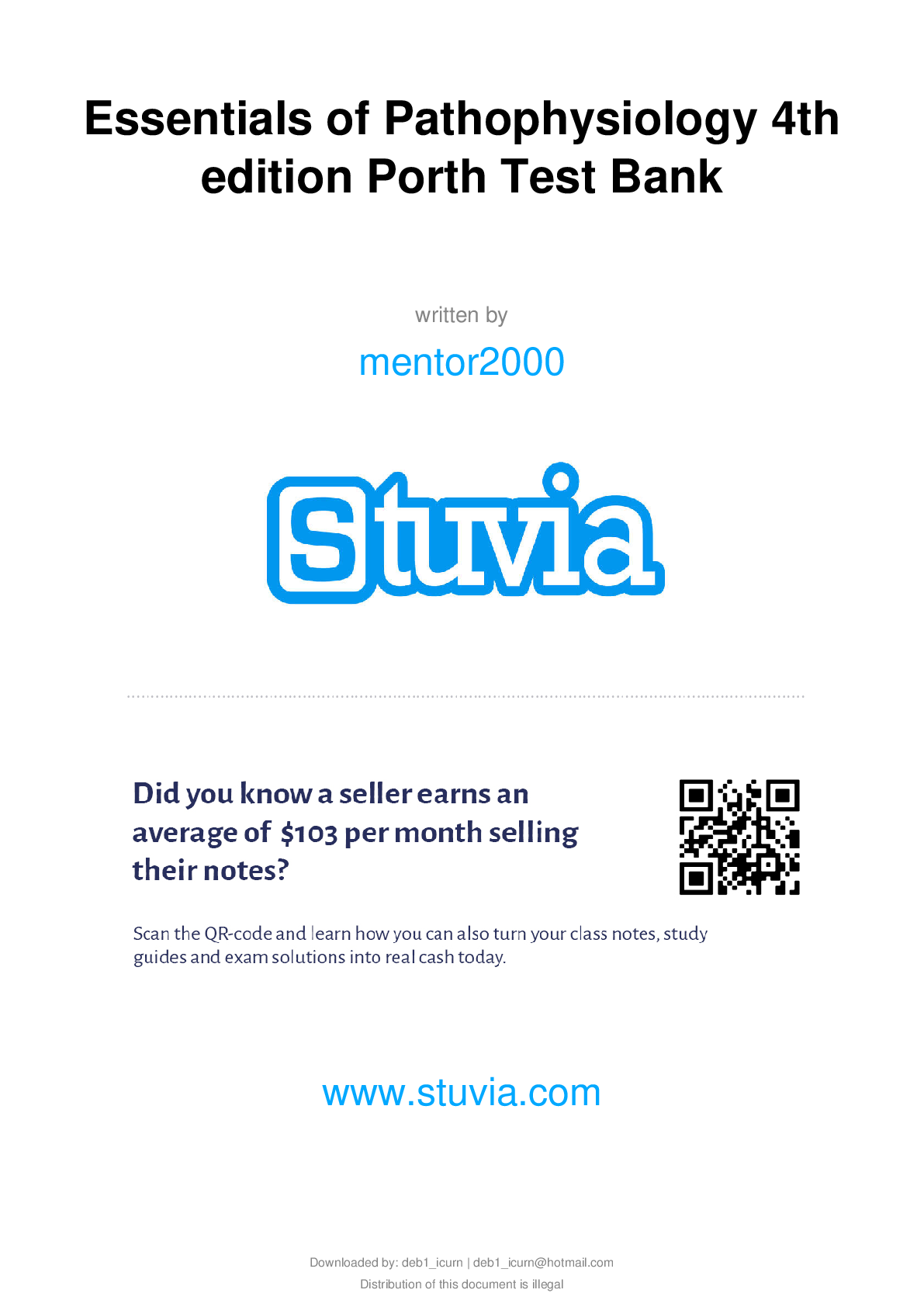

.png)
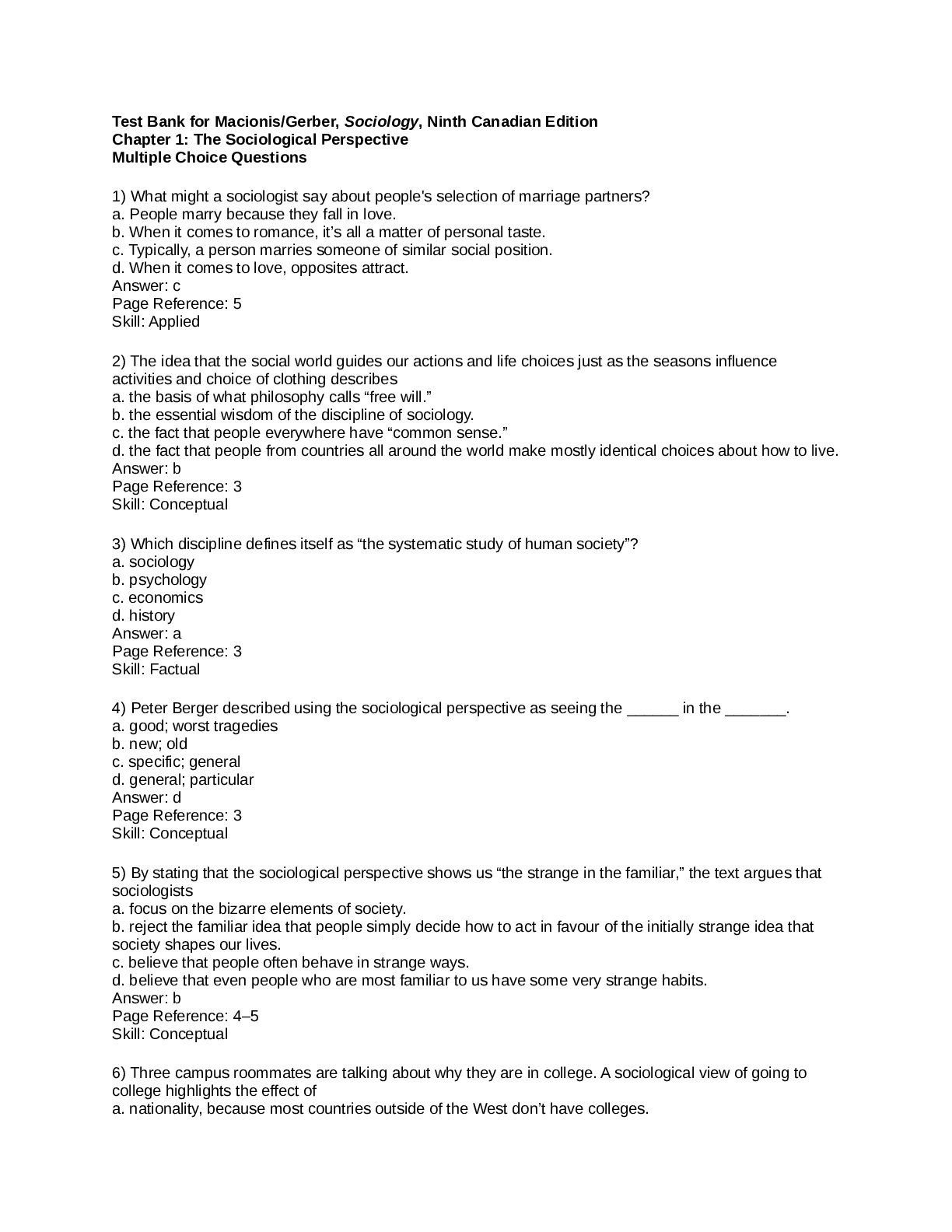
.png)
.png)
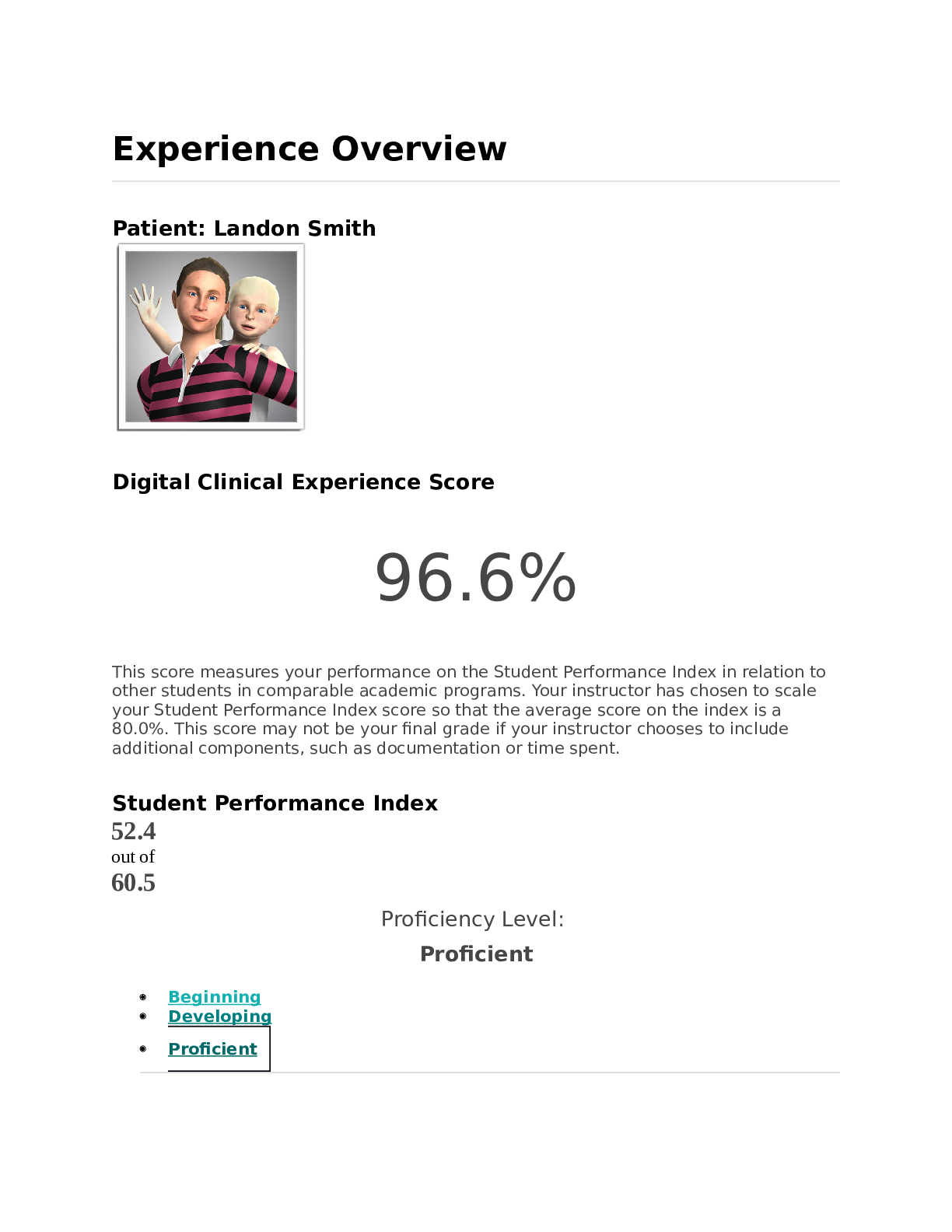
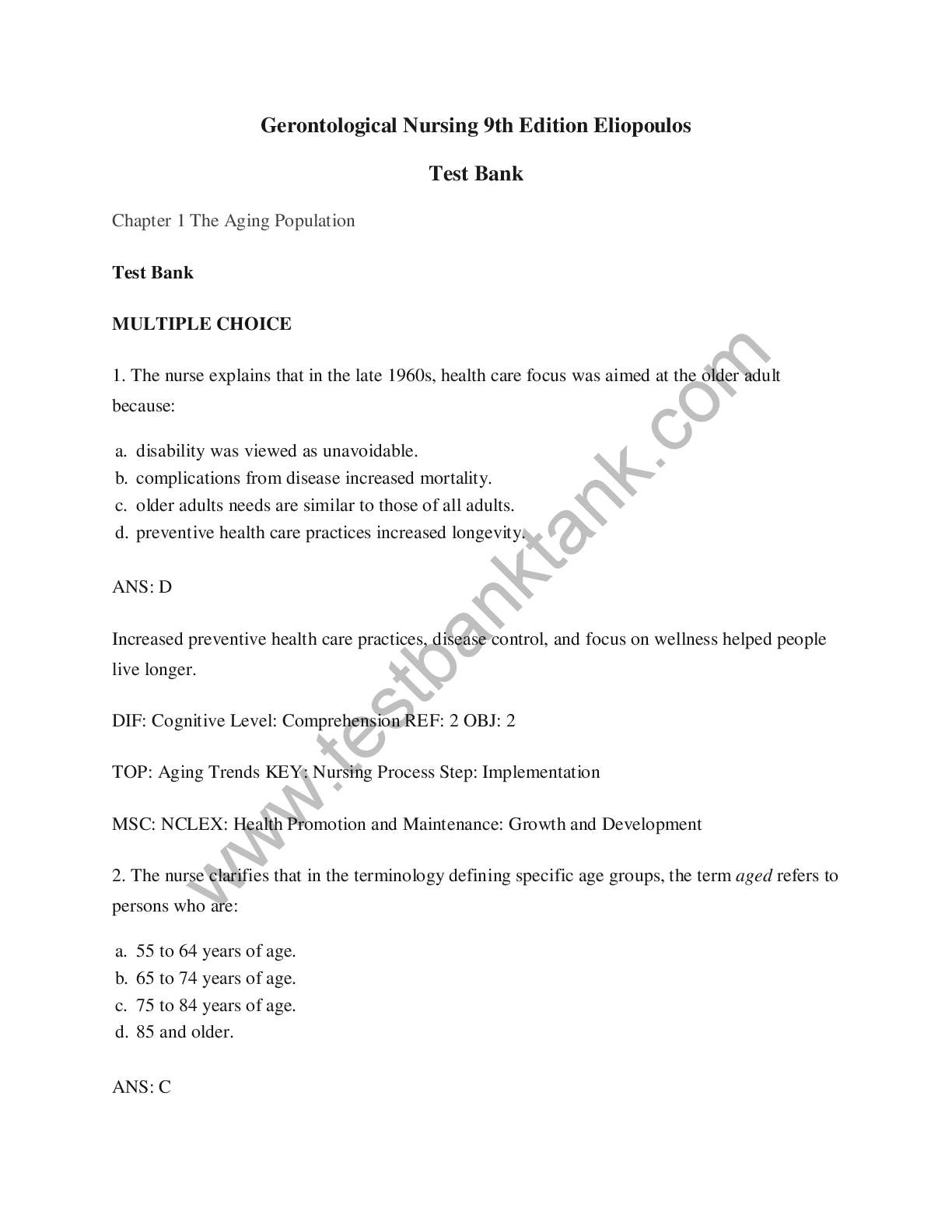

.png)
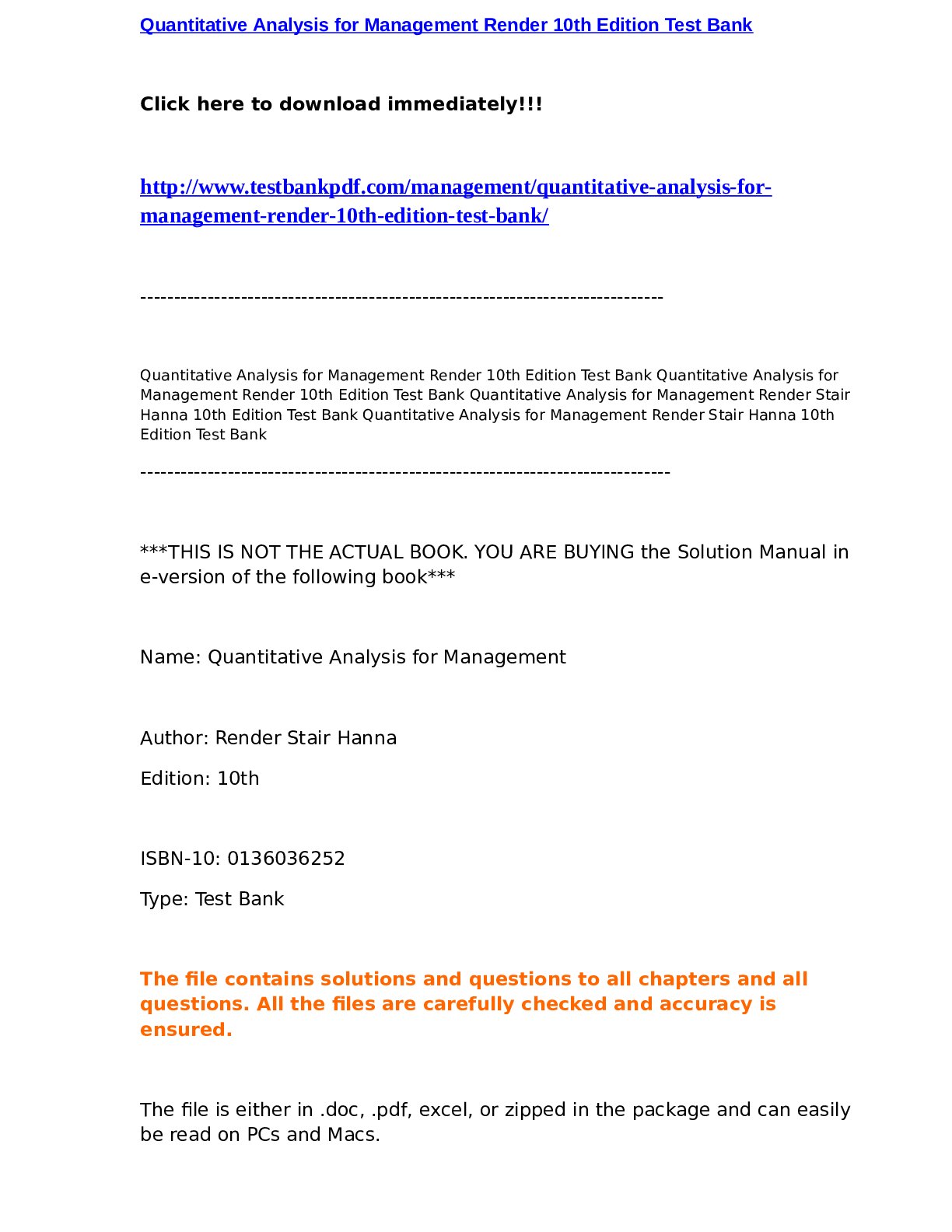
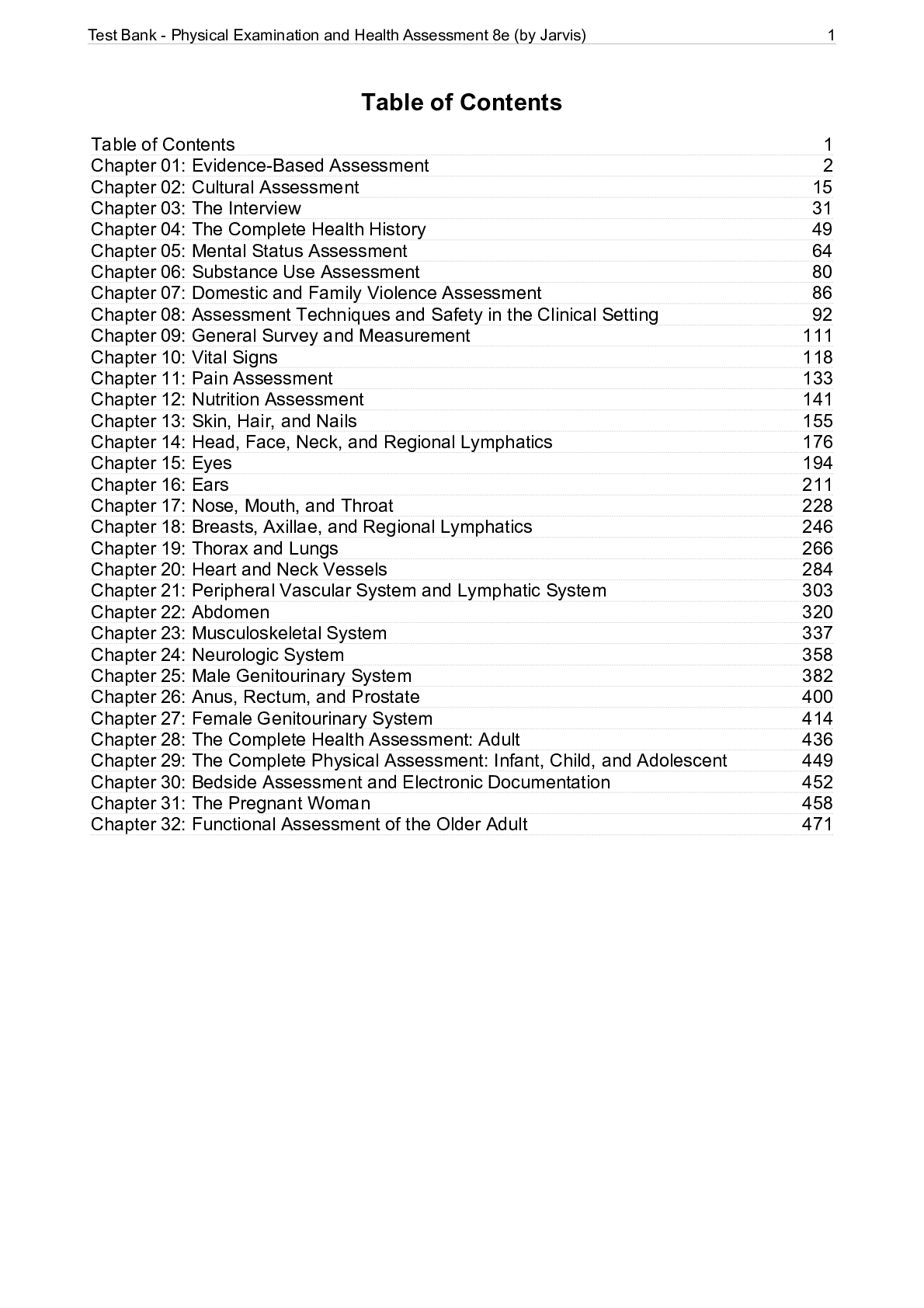

.png)
.png)

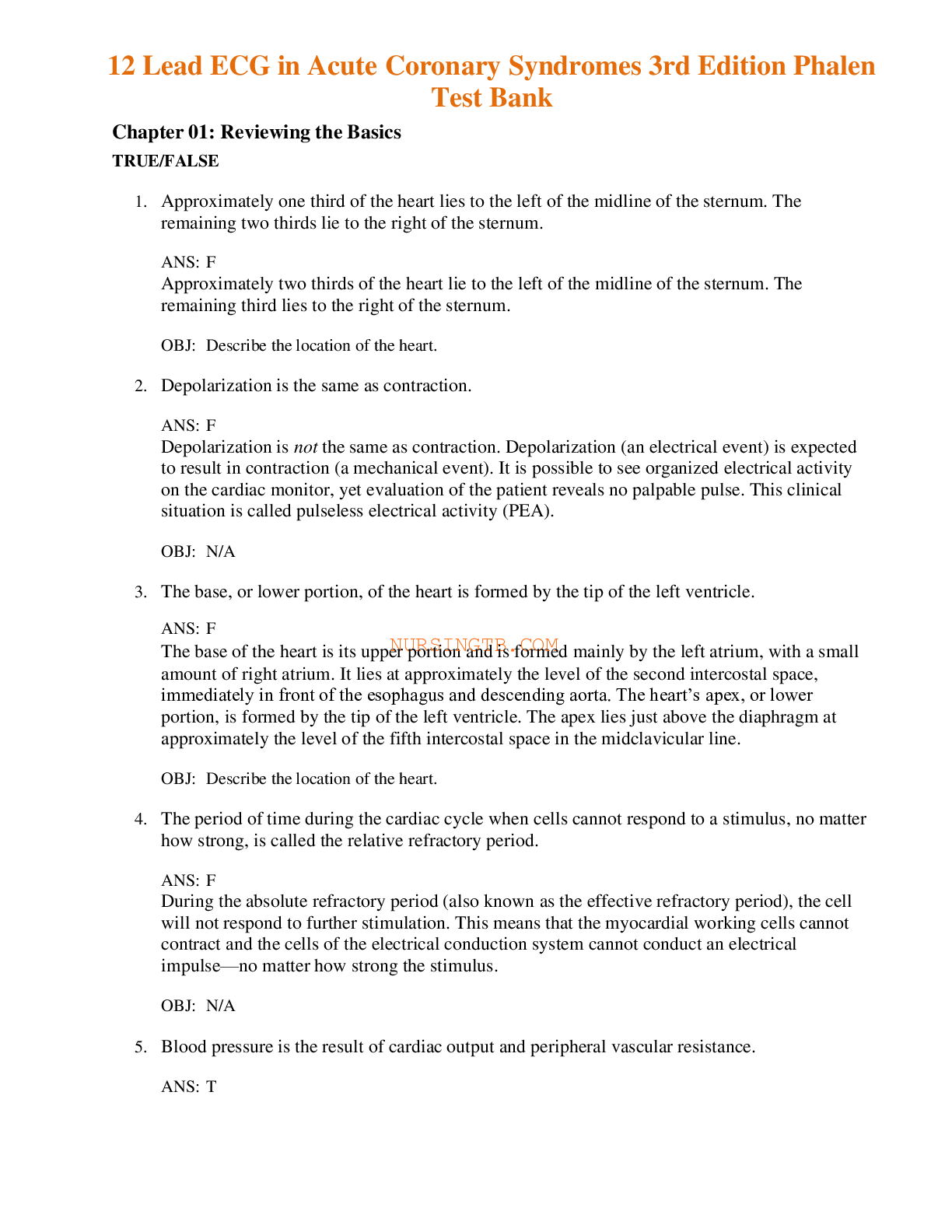

.png)

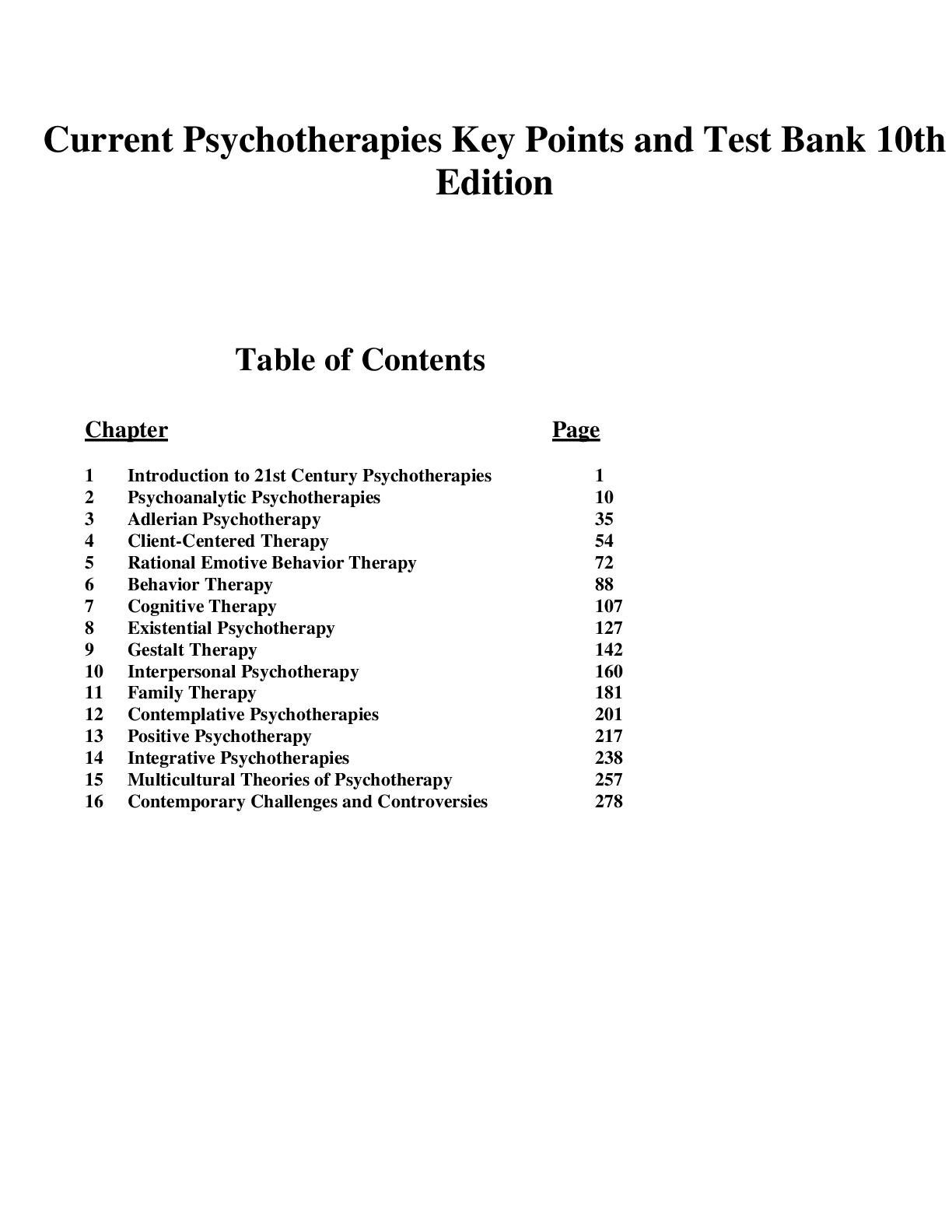



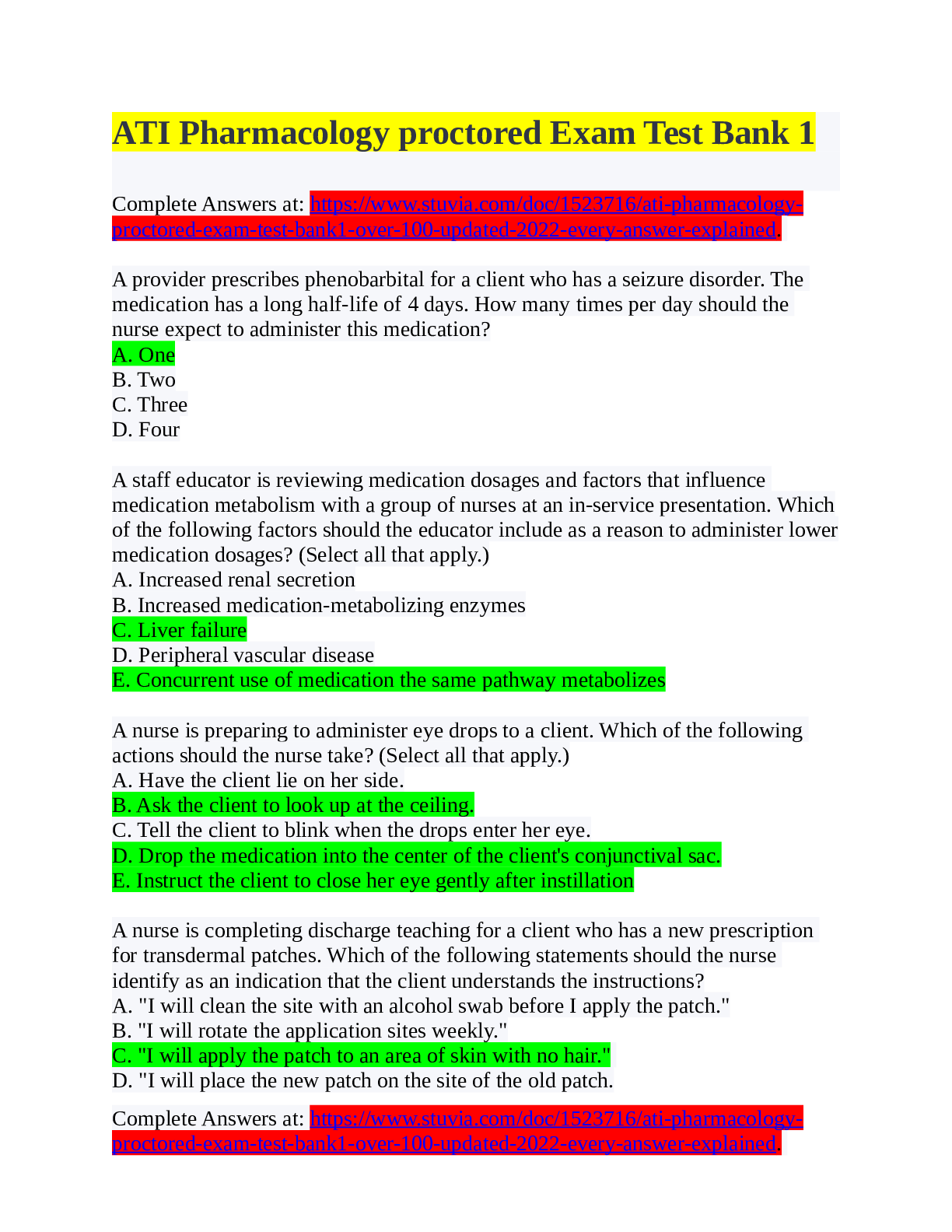
.png)

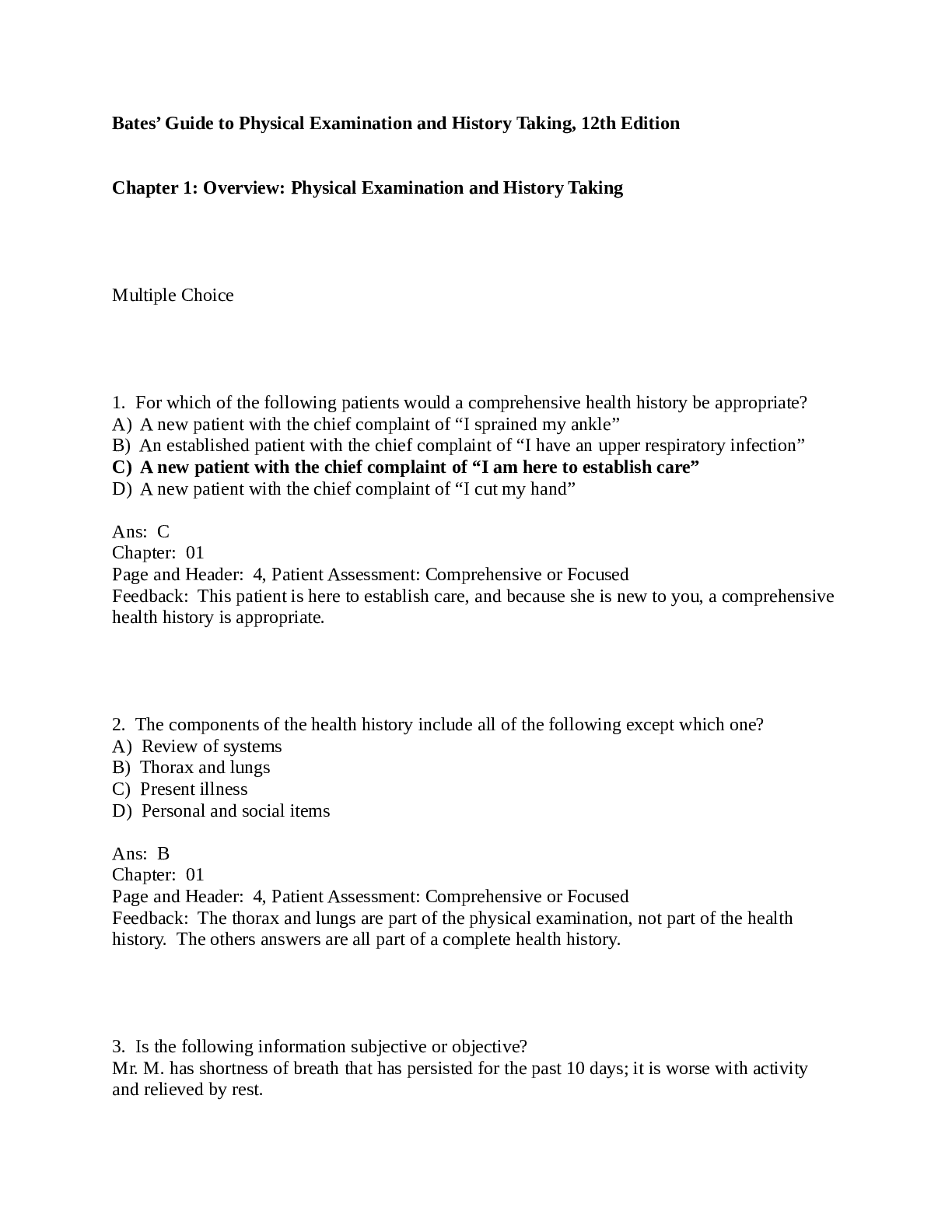
.png)
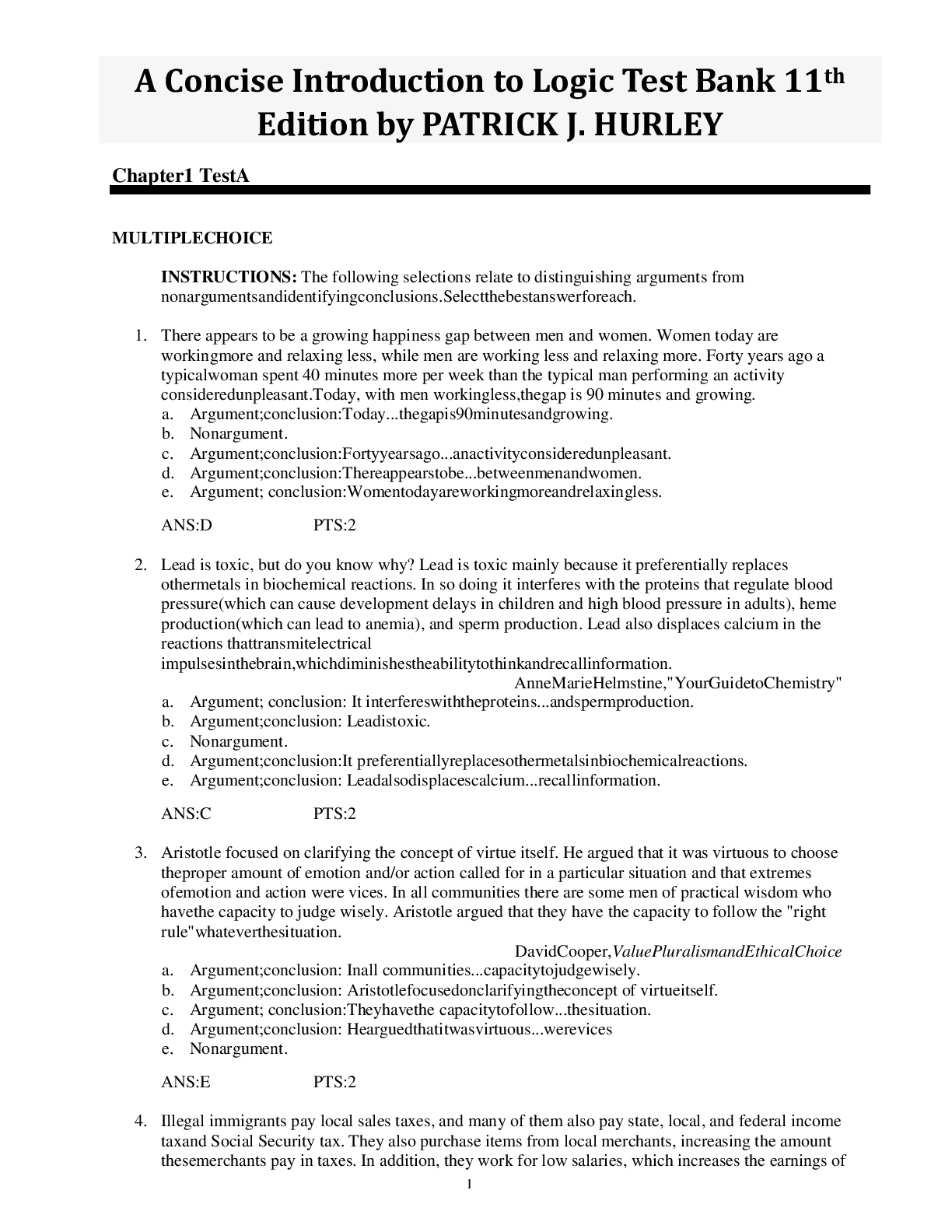

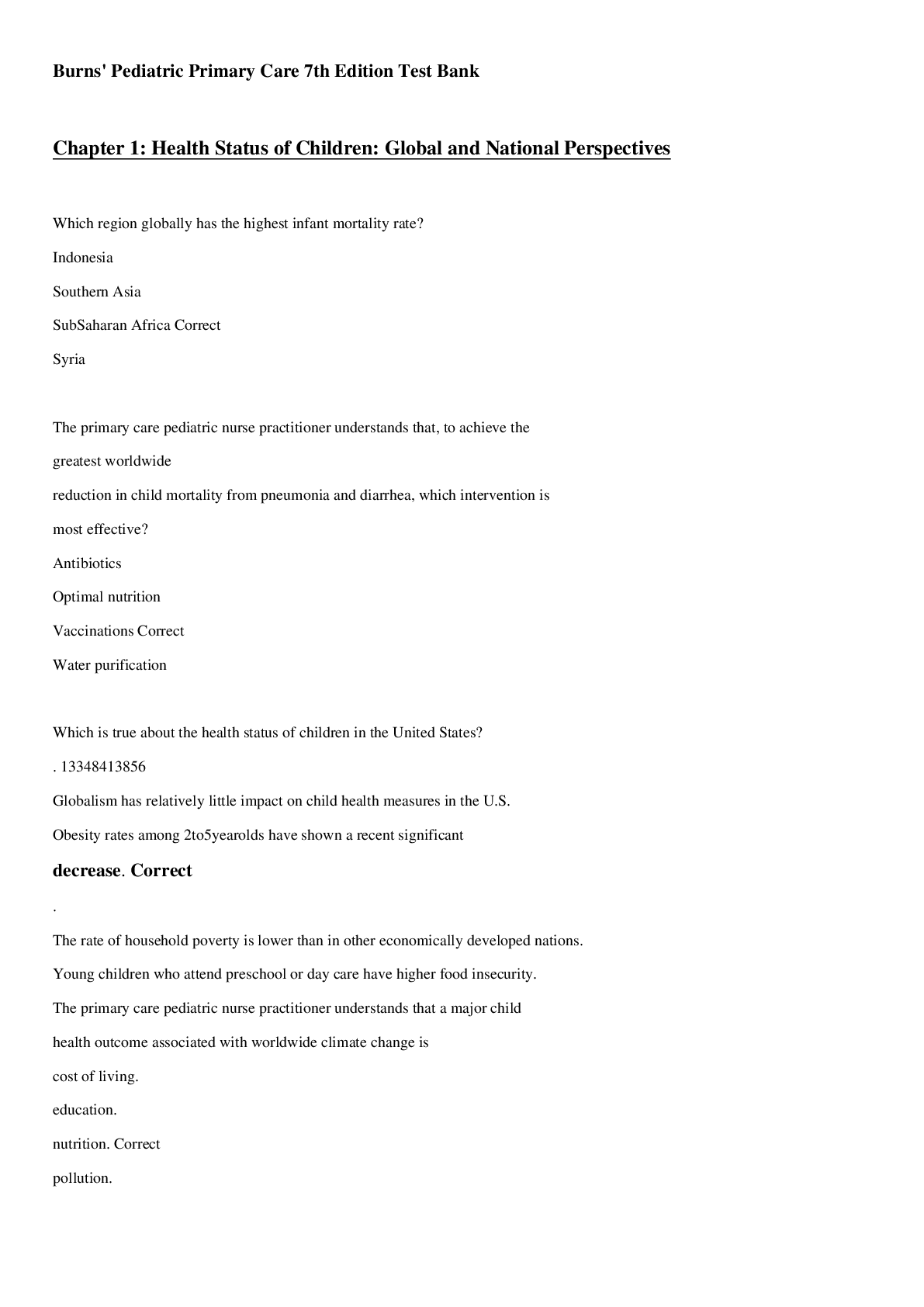
.png)

